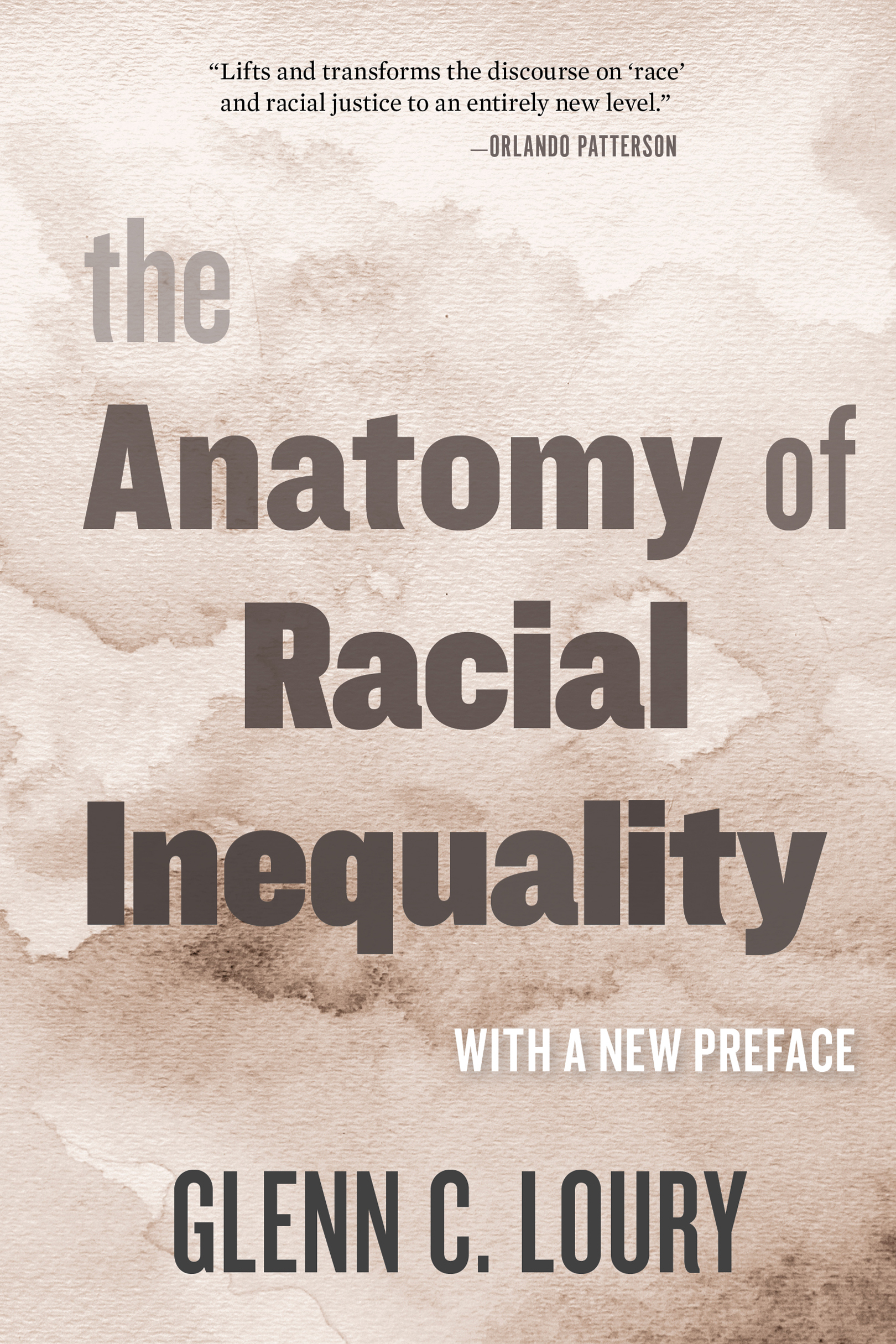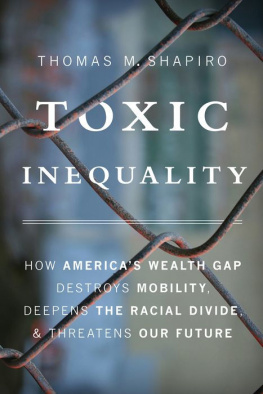Glenn C. Loury - The anatomy of racial inequality with a new preface
Here you can read online Glenn C. Loury - The anatomy of racial inequality with a new preface full text of the book (entire story) in english for free. Download pdf and epub, get meaning, cover and reviews about this ebook. year: 2021, genre: Politics. Description of the work, (preface) as well as reviews are available. Best literature library LitArk.com created for fans of good reading and offers a wide selection of genres:
Romance novel
Science fiction
Adventure
Detective
Science
History
Home and family
Prose
Art
Politics
Computer
Non-fiction
Religion
Business
Children
Humor
Choose a favorite category and find really read worthwhile books. Enjoy immersion in the world of imagination, feel the emotions of the characters or learn something new for yourself, make an fascinating discovery.

- Book:The anatomy of racial inequality with a new preface
- Author:
- Genre:
- Year:2021
- Rating:4 / 5
- Favourites:Add to favourites
- Your mark:
- 80
- 1
- 2
- 3
- 4
- 5
The anatomy of racial inequality with a new preface: summary, description and annotation
We offer to read an annotation, description, summary or preface (depends on what the author of the book "The anatomy of racial inequality with a new preface" wrote himself). If you haven't found the necessary information about the book — write in the comments, we will try to find it.
The anatomy of racial inequality with a new preface — read online for free the complete book (whole text) full work
Below is the text of the book, divided by pages. System saving the place of the last page read, allows you to conveniently read the book "The anatomy of racial inequality with a new preface" online for free, without having to search again every time where you left off. Put a bookmark, and you can go to the page where you finished reading at any time.
Font size:
Interval:
Bookmark:

The Anatomy of Racial Inequality
With a New Preface
GLENN C. LOURY
HARVARD UNIVERSITY PRESS
Cambridge, Massachusetts, and London, England
Copyright 2002 by Glenn C. Loury
Preface to the Second Paperback Edition
copyright 2021 by Glenn C. Loury
All rights reserved
First Harvard University Press hardcover edition, 2002
First Harvard University Press paperback edition, 2003
Cover art: Stella Levi
Cover design: Lisa Roberts
9780674269859 (EPUB)
9780674269880 (PDF)
Library of Congress Cataloging-in-Publication Data is available from loc.gov
ISBN 978-0-674-26046-7 (pbk.)
It is to the memory of my dear, departed wife, the economist Linda Datcher Loury, that I proudly dedicate this new edition of The Anatomy of Racial Inequality.
When, in the spring of 1999, the call came from Skip Gates inviting me to present the prestigious Du Bois Lectures at Harvards African and African American Studies Department the following April, I was delighted. I fancied myself a proverbial prodigal son, as the event marked my triumphant return to Harvard nearly a decade after having moved across the Charles River to Boston University, seeking greener pastures in the midst of a midlife crisis. In retrospect, I was determinedcravenly so, it is now clearto prove how stridently at odds I had come to be with American conservatism on racial issues. Indeed, it pains me now, some two decades on, to realize how badly I needed acceptance and affirmation from Harvards Negro cognoscenti. Presenting those three lectures, The Economics and Ethics of Racial Classification, in April 2000, and seeing them published by Harvard University Press as The Anatomy of Racial Inequality in 2002, confirmed that I had, at long last, come home. I can still feel the warm glow of satisfaction that washed over me while being introduced before each talkin flattering terms, to overflow crowdsby the eminent black scholars William Julius Wilson, Lawrence Bobo, and Kwame Anthony Appiah. Here, finally, was my chance to deploy all of my social scientific and expository powers to inveigh against the evils of racial inequality and to defend the dignity of our people. I was determined to atone for my apostasy and, so it now appears upon rereading the text, I succeeded admirably! Such was the emotional impetus driving me to write this book.
But the arguments on offer here sprang from my head as much as from my heart. Again, my time at Harvard in the 1980s was crucial. For that is where I encountered Thomas Schelling, the Nobel Prize winning economist, who passed away in 2016. We worked together for nearly a decade at the Kennedy School of Government, and I learned much from him. We created and co-taught for several years a course called Public Policy in Divided Societies. There I encountered and read deeply writers such as Amartya Sen (Rational Fools); Albert Hirschman (Exit, Voice, and Loyalty); Erving Goffman (The Presentation of Self in Everyday Life); David Lewis (Convention); Leo Strauss (Persecution and the Art of Writing); Kenneth Arrow (Social Choice and Individual Values); Robert K. Merton (The Self-Fulfilling Prophecy); Howard Raiffa (Negotiation Analysis); Mancur Olson (The Logic of Collective Action); Michael Spence (Job Market Signaling); Harold Isaacs (Idols of the Tribe); Jon Elster (Sour Grapes); and Michael Walzer (Spheres of Justice). This experience of teaching with Tom more than three decades ago laid the intellectual foundations for this book. It broadened my horizons beyond the narrow confines of technical economic theory. It showed me the power of strategic analysis to illuminate questions about identity, inequality, social ethics, and imperfect rationality. It inspired me to study in comparative spirit a wide range of real-world phenomena.
With Toms encouragement, our students investigated topics such as the plight of Roma in Europe and the indigenous in Central America; caste in India and slave maroon communities in the Caribbean; skin color hierarchies in nineteenth-century cities like New Orleans and Charleston; debates among the Deaf community over sign language versus lipreading; changing ones name or accent to disguise ethnic/regional origins; collective punishment; group-based feelings of pride and shame; the problems any group faces to maintain a public reputation; inequality-promoting implications of endogamy and assortative mating; racial profiling; complementarity between sexual divisions of labor at home and in the workplace, and so much more.
Beyond this, Tom Schelling helped me see how an open-minded economist can theorize rigorously about such ubiquitous social phenomena as rumors; seduction; plausible deniability; dog-whistle politics; riots; signaling; passing for white; usage of expressive imprecision; group think; code words; discursive taboos; naked emperors; ones knowledge of the others state of knowledge; the subtle differences between promises, threats, and bluffs, and so on. Such was the intellectual feast I enjoyed in the 1980s, which empowered me years later to write these lectures.
As for the book itself, The Anatomy of Racial Inequality sought to do three things: outline a theory of race applicable to social and historical circumstances in the United States; sketch an account of the stubborn persistence of racial inequality in America; and offer a conceptual framework for social criticism on race-related issues, so as to influence political and intellectual elites on behalf of a program of reform. Today I stand by my analysis of the first two themes, but I have come to have considerable misgivings concerning what I had to say about the third one.
Looking back, with two decades of hindsight, I remain proud of what I accomplished in this book, notwithstanding its emotional origins in what was a jumble of guilt, regret, self-doubt, and virtue signaling. It is rigorously argued. It explores deep problems in economics, sociology, politics, and social ethics. And, though there is not a single equation in the text, it illustrates how much light an economists formal framing can shed on one of the central moral questions of our time. Although I would not argue in exactly the same way today, for reasons discussed below, I have decided to resist the temptation to rewrite history. So, the original text of my 2002 book is presented here, unamended. Racial stereotypes, racial stigma, and racial justicethese were the themes of my lectures. Permit me to introduce this newly released edition with a brief discussion of each.
Any theory of race must reckon with the fact that people take note of and assign significance to superficial markings on the bodies of other human beingstheir skin color, hair texture, facial bone structures, and so forth. This universal human practice appears to have a deep neurological foundation. This is the point of departure for my analysis. I refer to a society as being raced when its members routinely partition the field of human subjects whom they encounter in that society into groups, where this sorting convention is based on the subjects possession of some cluster of observable bodily marks. This leads to my claim that, at bottom, race is all about embodied social signification. Let us call this the
Font size:
Interval:
Bookmark:
Similar books «The anatomy of racial inequality with a new preface»
Look at similar books to The anatomy of racial inequality with a new preface. We have selected literature similar in name and meaning in the hope of providing readers with more options to find new, interesting, not yet read works.
Discussion, reviews of the book The anatomy of racial inequality with a new preface and just readers' own opinions. Leave your comments, write what you think about the work, its meaning or the main characters. Specify what exactly you liked and what you didn't like, and why you think so.




